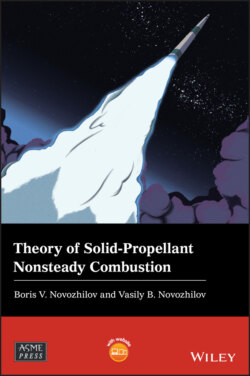Theory of Solid-Propellant Nonsteady Combustion

Реклама. ООО «ЛитРес», ИНН: 7719571260.
Оглавление
Vasily B. Novozhilov. Theory of Solid-Propellant Nonsteady Combustion
Table of Contents
List of Tables
List of Illustrations
Guide
Pages
Wiley‐ASME Press Series
Theory of Solid-Propellant Nonsteady Combustion
Copyright
About the Authors. Professor Boris V. Novozhilov
Professor Vasily B. Novozhilov
Preface
Important Notation and Abbreviations. Abbreviations
Mathematical Functions
Notation
Greek
Gothic
Superscripts
Subscripts
About the Companion Website
1 Steady‐state Combustion. 1.1 General Characteristics of Solid Propellants
1.2 Burning Rate and Surface Temperature
1.3 Combustion Wave Structure. Burning Temperature
1.4 Combustion in Tangential Gas Stream
1.5 Gaseous Flame
1.6 Combustion Waves in the Condensed Phase
1.7 The Two Approaches to the Theory of Nonsteady Propellant Combustion
1.8 Steady‐state Belyaev Model
2 Equations of the Theory of Nonsteady Combustion
2.1 Major Assumptions
2.2 Zeldovich Theory: Constant Surface Temperature
2.3 Variable Surface Temperature
2.4 Integral Formulation of the Theory
2.5 Theory Formulation through the Set of Ordinary Differential Equations
2.6 Linear Approximation
2.7 Formal Mathematical Justification of the Theory
3 Combustion Under Constant Pressure
3.1 Stability Criterion for a Steady‐state Combustion Regime
3.2 Asymptotical Perturbation Analysis
3.3 Two‐dimensional Combustion Stability of Gasless Systems
3.4 Combustion Beyond the Stability Region
3.5 Comparison with Experimental Data
4 Combustion Under Harmonically Oscillating Pressure
4.1 Linear Burning Rate Response to Harmonically Oscillating Pressure
4.2 Acoustic Admittance of Propellant Surface
4.3 Quadratic Response Functions
4.4 Acoustic Admittance in the Second‐order Approximation
4.5 Nonlinear Resonance
4.6 Response Function Bifurcations
4.7 Frequency–Amplitude Diagram
4.8 Comparison with Experimental Data
5 Nonsteady Erosive Combustion. 5.1 Problem Formulation
5.2 Linear Approximation
5.3 Nonlinear Effects in Nonsteady Erosive Combustion
6 Nonsteady Combustion Under External Radiation. 6.1 Steady‐state Combustion Regime
6.2 Heat Transfer Equation in the Linear Approximation
6.3 Linearization of Nonsteady Burning Laws
6.4 Steady‐state Combustion Regime Stability
6.5 Burning Rate Response to Harmonically Oscillating Pressure
6.6 Burning Rate Response to Harmonically Oscillating Radiative Flux
6.7 Relation Between Burning Rate Responses to Harmonically Oscillating Pressure and Radiative Flux
7 Nonacoustic Combustion Regimes. 7.1 Acoustic and Nonacoustic Combustion Regimes
7.2 Linear Approximation
7.3 Approximate Approach in the Theory of Nonsteady Combustion
7.4 Self‐similar Solution
7.5 Self‐similar Solution Stability
7.6 Propellant Combustion and Extinction Under Depressurization: Constant Surface Temperature
7.7 Propellant Combustion and Extinction Under Depressurization: Variable Surface Temperature
8 Modelling Nonsteady Combustion in a Solid Rocket Motor
8.1 Introduction
8.2 Nonacoustic Regimes: Problem Formulation
8.3 Stability of the Steady‐state Regime in a Semi‐enclosed Volume
8.4 Transient Regimes
8.5 Unstable and Chaotic Regimes
8.6 Experimental Data
8.7 Acoustic Regimes
8.8 Automatic Control of Propellant Combustion Stability in a Semi‐enclosed Volume
9 Influence of Gas‐phase Inertia on Nonsteady Combustion
9.1 Introduction
9.2 Steady‐state Combustion Regime Stability
9.3 Burning Rate Response to Harmonically Oscillating Pressure
9.4 Acoustic Admittance of the Propellant Surface
9.5 Combustion and Extinction Under Depressurization
9.6 tr Approximation
References
Theory of Solid‐Propellant Nonsteady Combustion. Problems
Theory of Solid‐Propellant Nonsteady Combustion. Problem Solutions
Index
WILEY END USER LICENSE AGREEMENT
Отрывок из книги
Computer Vision for Structural Dynamics and Health Monitoring
Dongming Feng, Maria Q. Feng
.....
Maan H. Jawad and Owen R. Greulich
Engineering Optimization: Applications, Methods and Analysis
.....